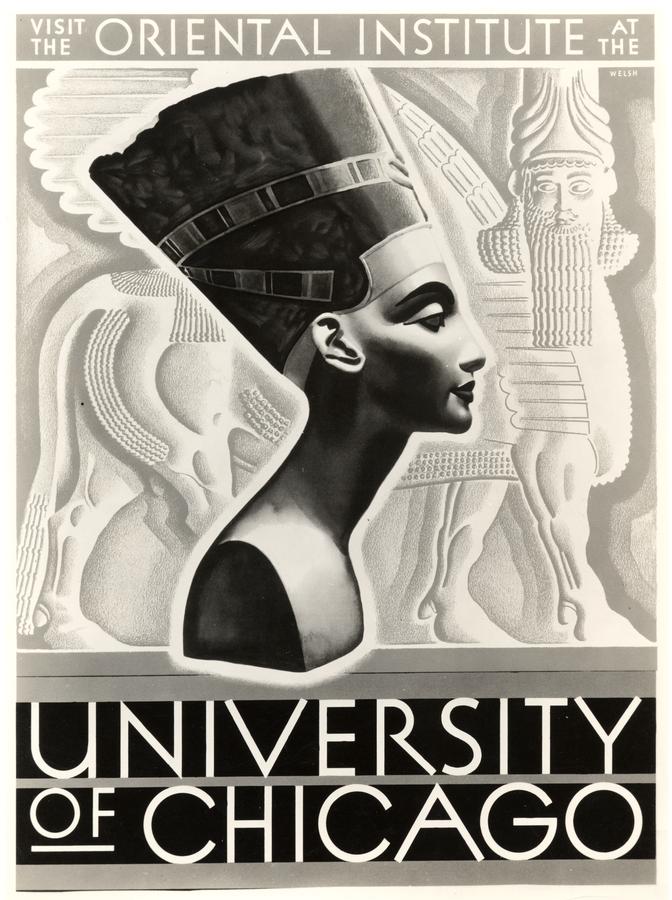
Visit changed the lives of king's devoted servants
A collaborative project intended to focus ideas and thoughts on the history of the Oriental Institute of The University of Chicago.

In the spring of 1919, James Henry Breasted, founder of the Oriental Institute, began a year long expedition to the Near East. Accompanied by Daniel D Luckenbill and several graduate students, Breasted travelled extensively through Egypt, Iraq, Syria, Lebanon, and Palestine. In these fiche, 163 of the photographs taken during Breasted's journey are arranged to follow the expedition's itinerary. They record the numerous archaeological sites that Breasted visited, the Arab and British leaders with whom he met, and scenes of contemporary native life. The accompanying text records the progress of the expedition, and identifies the describes the photographs. vi + 30p, 1 map (booklet), 2 b/w fiche (163 frames) (Microeditions Special Publications, Oriental Institute 1977)The book seems to be available for an excellent price from DBB. I'm led to believe that this text/fiche publication will also appear online in some form during the exhibit.
 OIP 136.
OIP 136.Purchase Book Download PDF Terms of Use
With the present volume the Epigraphic Survey returns to its series of publications dedicated to the reliefs and inscriptions of the Medinet Habu complex, a series inaugurated in 1930 with the publication of the war scenes and earlier historical records from the mortuary temple of Ramesses III (Medinet Habu I. Earlier Historical Records of Ramses III, The Epigraphic Survey, Oriental Institute Publications 8, 1930). The Ramesside temple and the High Gate were to occupy the efforts of the Survey for the next four decades, ending in 1970 with the appearance of Medinet Habu VIII. In resuming the Medinet Habu series, the Survey initiates what is envisioned to be a sequence of five volumes documenting the Eighteenth Dynasty temple of Amun and subsequent additions thereto, beginning with this publication of the reliefs in the six innermost rooms of the temple. These chambers were begun during the coregency of Hatshepsut and Thutmose III and completed by the latter king during his sole reign.
OI Splendors of the Nile is a photographic and textual complement to the Oriental Institute's Splendors of the Nile program escorted by Dr. Nadine Moeller.
This trip is a great introduction to Egypt and a treat for anyone who wants to see Egypt through the eyes of a Nile traveler. We will experience many of the famous landmarks of Egyptian history as well as exclusive site visits and on-site learning.

The Research Archives needs your help to maintain its position as the premier library for ancient Near Eastern studies in the Western Hemisphere. The Adopt-a-Journal Campaign is an opportunity to provide the library with its most valuable asset and demonstrate your commitment to the preservation of knowledge and learning for future generations of Oriental Institute members, scholars, students, and visitors.
Donors to the program can choose to adopt a journal annually, create a fund to ensure long-term support, or donate a personal copy of a specific journal needed in the collection. Every dollar donated goes toward purchasing new volumes, above and beyond our current subscriptions. We are pleased to recognize our donors with a permanent, personalized bookplate in the books and journals that they sponsor, as well as a mention in the pages of the Oriental Institute Annual Report. If you would like information about how to sponsor a journal, please contact Foy Scalf via phone at (773) 702-9537 or via email. We can provide you with a list of adoptable journals in your field of interest as well as the costs for sponsoring those journals. We are very grateful for your sponsorship.



You can adopt-a-journal through our online pledge form. Under “Purpose of Gift,” simply check the box for “Research Archives Library” and type “100%” in the box (unless you are giving multiple gifts to multiple departments). Then in the “Special Instructions” field, you can simply tell us which journal(s) you would like to adopt and for how long.
You could also simply write a check made out to the “Oriental Institute” and send it to the following address:
Research Archives
Oriental Institute
1155 East 58th Street
Chicago, IL 60637
Please be sure to include your instructions concerning which journal(s) you would like to sponsor. After receipt, a unique bookplate will be designed to honor your generosity and a copy will be sent to you via email.
Futher information on the Research Archives at the OIHistory blog:
A 300-pound fragment of a human-headed winged bull from the Neo-Assyrian city of Khorsabad sits on a table in the Oriental Institute’s conservation laboratory. The fragment, made of gypsum, is about to get the most attention it’s had since a team of archaeologists excavated it more than 70 years ago in northern Iraq.
Alison Whyte, Assistant Conservator, guides a small vacuum nozzle over the fragment’s surface—past its carved rosette decorations and over tiny bits of dirt, some of which are more than 2,000 years old. She uses a small artist’s brush with especially fine bristles to sweep up the dust...





